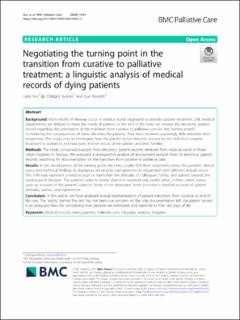| dc.description.abstract | Background: Many deaths in Norway occur in medical wards organized to provide curative treatment. Still, medical departments are obliged to meet the needs of patients at the end of life. Here, we analyse the electronic patient record regarding documentation of the transition from curative to palliative care (i.e. the ‘turning point’). Considering the consequences of these decisions for patients, they have received surprisingly little attention from researchers. This study aims to investigate how the patient record denotes reasons for the shift from curative treatment to palliation and how texts involve voices of the patient and their families.
Methods: The study comprised excerpts from electronic patient records retrieved from medical wards in three urban hospitals in Norway. We executed a retrospective analysis of anonymized extracts from 16 electronic patient records, searching for documentation on the transition from curative to palliative care.
Results: In the development of the turning point, the texts usually shift from statements about the patient’s clinical status and technical findings to displaying uncertainty and openness to negotiation with different textual voices. This shift may represent a need to align or harmonize the attitudes of colleagues, family, and patient towards the turning-point decision. The patient’s voice is mostly absent or reported only briefly when, in their notes, nurses gave an account of the patient’s opinion. None of the physicians’ notes provided a detailed account of patient attitudes, wishes, and experiences.
Conclusion: In this article, we have analysed textual representations of patient transitions from curative to end-oflife care. The ‘reality’ behind the text has not been our concern. As the only documentation left, the patient record is an adequate basis for considering how patients are estimated and cared for in their last days of life. | en_US |
